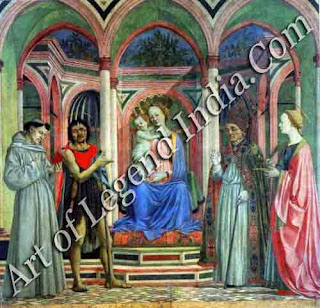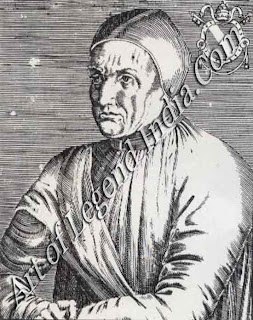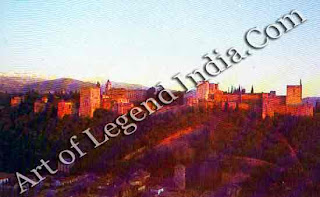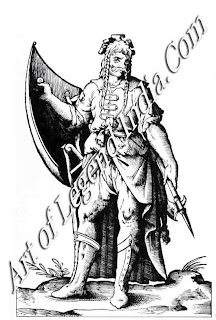 1445
1445
The
year fell in a fundamentally unstable period. The Muscovites were beginning to
chafe under their Tatar overlords while in Europe, France and England had made
a temporary peace cemented by marriage. However, by the end of the year, the
two countries were to be on the verge of further hostilities.
In 1445
Renaissance art was maturing rapidly and its masters were busy, much-travelled
men. Uccello went to Padua to join his sculptor friend Donatello and executed
his now-vanished painting of 'Giants'. Donatello, the Florentine sculptor, was
working on his monument to the Venetian condottiere Gattamelata. This was an
awe-inspiring feat in contemporary eyes, since it was the first equestrian
statue since Roman times. In Florence itself, Domenico Veneziano, Ghiberti and
Andrea del Castagno were creating masterpieces, and Michelozzo was engaged in
building the first of the great Renaissance palaces, dedicated to the glory of
the ruling Medici family.
 The new
spirit of enterprise was also strong among the Portuguese, whose navigators
were steadily working their way down the west coast of Africa. In 1445 it was
Alvaro Fernandes who under the protection of Henry the Navigator, reached the
Cape of Masts.
The new
spirit of enterprise was also strong among the Portuguese, whose navigators
were steadily working their way down the west coast of Africa. In 1445 it was
Alvaro Fernandes who under the protection of Henry the Navigator, reached the
Cape of Masts.
Even on
the semi-barbarous Eurasian steppes, great changes were taking place. The Tatar
Golden Horde was now beginning to disintegrate into separate khanates,
foreshadowing an end to the two centuries of empire that had begun with Genghis
Khan. The future lay with one of the Horde's client states, the Grand Duchy of
Moscow. But this was still far from clear in 1445, when Grand Duke Vassily II
made war on the Tatar Khan Ulugh Mahmed. Vassily was ignominiously defeated,
captured, and only released after agreeing to pay an indemnity. The situation
on both sides was so unstable that, within a few months, Vassily had been
deposed and blinded by his rival Dmitry Shemyaka, while Ulugh Mahmed was
murdered by his own son, Mahmudek.

In the
West, war and politics were rather less savagely conducted, though the code of
chivalry did not prevent the Dauphin Louis from plotting against his father,
King Charles VII of France. Although England and France remained in the grip of
the Hundred Years War, peace seemed imminent in 1445: the two sides had agreed
on a truce, and, in April, Henry VI of England took a bride with King Charles'
approval.
A SHORT-LIVED PEACE
 His
betrothed was fifteen-year-old Margaret of Anjou, Princess of Sicily,
Jerusalem, Cyprus, Majorca, Provence and Lorraine. Unfortunately, most of these
were paper titles, and Margaret's father, Rene of Anjou was in fact a
.charmingly impecunious adventurer who lived off his wife's. Inheritance, the
duchy of Lorraine; Margaret's dowry consisted of Majorca and Minorca claimable
if Henry VI cared to mount an expedition to the Mediterranean and win them from
their actual ruler, the King of Aragon. Nonetheless the wedding was a splendid
affair, attended by the international elite or their representatives and taking
place at Nancy Cathedral in Lorraine. The bride wore a dress of white satin
sewn with 'her' flowers marguerites in silver and gold. The groom was
represented by a proxy, William de la Pole, Duke of Suffolk, who was
accompanied by an escort that had been transported in some 70 ships. Eight days
of feasts, minstrelsy and jousting followed the ceremony, making this one of
the most memorable occasions in an age obsessed with pageantry.
His
betrothed was fifteen-year-old Margaret of Anjou, Princess of Sicily,
Jerusalem, Cyprus, Majorca, Provence and Lorraine. Unfortunately, most of these
were paper titles, and Margaret's father, Rene of Anjou was in fact a
.charmingly impecunious adventurer who lived off his wife's. Inheritance, the
duchy of Lorraine; Margaret's dowry consisted of Majorca and Minorca claimable
if Henry VI cared to mount an expedition to the Mediterranean and win them from
their actual ruler, the King of Aragon. Nonetheless the wedding was a splendid
affair, attended by the international elite or their representatives and taking
place at Nancy Cathedral in Lorraine. The bride wore a dress of white satin
sewn with 'her' flowers marguerites in silver and gold. The groom was
represented by a proxy, William de la Pole, Duke of Suffolk, who was
accompanied by an escort that had been transported in some 70 ships. Eight days
of feasts, minstrelsy and jousting followed the ceremony, making this one of
the most memorable occasions in an age obsessed with pageantry.
Charles
VII's benevolent attitude formed part of his diplomatic and military
preparation for a new drive against the English. This year saw the second of
three ordinances in which he quietly created what was to become the first
French regular standing army who would remain permanently in the royal service.
On the political front it was agreed that Henry would cede the province of
Maine to his in-laws in effect, to the King of France. Anxious for peace, Henry
agreed to the plan on 22 December but his subjects simply refused to carry out
the agreement, and a long crisis of authority began. English policy collapsed
into confusion, and in a remarkably short time, because of the events of 1445,
France was lost and England was being ravaged by civil war.
Writer
– Marshall Cavendish
 The new
spirit of enterprise was also strong among the Portuguese, whose navigators
were steadily working their way down the west coast of Africa. In 1445 it was
Alvaro Fernandes who under the protection of Henry the Navigator, reached the
Cape of Masts.
The new
spirit of enterprise was also strong among the Portuguese, whose navigators
were steadily working their way down the west coast of Africa. In 1445 it was
Alvaro Fernandes who under the protection of Henry the Navigator, reached the
Cape of Masts.  His
betrothed was fifteen-year-old Margaret of Anjou, Princess of Sicily,
Jerusalem, Cyprus, Majorca, Provence and Lorraine. Unfortunately, most of these
were paper titles, and Margaret's father, Rene of Anjou was in fact a
.charmingly impecunious adventurer who lived off his wife's. Inheritance, the
duchy of Lorraine; Margaret's dowry consisted of Majorca and Minorca claimable
if Henry VI cared to mount an expedition to the Mediterranean and win them from
their actual ruler, the King of Aragon. Nonetheless the wedding was a splendid
affair, attended by the international elite or their representatives and taking
place at Nancy Cathedral in Lorraine. The bride wore a dress of white satin
sewn with 'her' flowers marguerites in silver and gold. The groom was
represented by a proxy, William de la Pole, Duke of Suffolk, who was
accompanied by an escort that had been transported in some 70 ships. Eight days
of feasts, minstrelsy and jousting followed the ceremony, making this one of
the most memorable occasions in an age obsessed with pageantry.
His
betrothed was fifteen-year-old Margaret of Anjou, Princess of Sicily,
Jerusalem, Cyprus, Majorca, Provence and Lorraine. Unfortunately, most of these
were paper titles, and Margaret's father, Rene of Anjou was in fact a
.charmingly impecunious adventurer who lived off his wife's. Inheritance, the
duchy of Lorraine; Margaret's dowry consisted of Majorca and Minorca claimable
if Henry VI cared to mount an expedition to the Mediterranean and win them from
their actual ruler, the King of Aragon. Nonetheless the wedding was a splendid
affair, attended by the international elite or their representatives and taking
place at Nancy Cathedral in Lorraine. The bride wore a dress of white satin
sewn with 'her' flowers marguerites in silver and gold. The groom was
represented by a proxy, William de la Pole, Duke of Suffolk, who was
accompanied by an escort that had been transported in some 70 ships. Eight days
of feasts, minstrelsy and jousting followed the ceremony, making this one of
the most memorable occasions in an age obsessed with pageantry. 












0 Response to "Italian Great Artist Paolo Uccello - A Year in the 1445"
Post a Comment